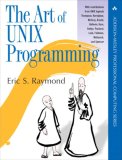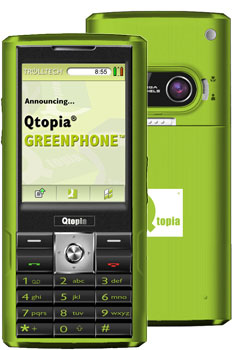Month 2007.09
Basics of the Unix Philosophy
Even though the title of this entry is Unix Philosophy, every programmer needs to read this if they are not familiar with it already. A while back I read a great book called The Art of UNIX Programming which may be read free online or purchased in paperback form. While the whole book is good and relevant for any programmer, one section really stood out in my mind.
In chapter 1 there is a section called Basics of the Unix Philosophy that lists a few different versions of programming rules by different authors. I feel that each of the lists are valid and should be considered by any software developer.
The first one is from "Doug McIlroy, the inventor of Unix pipes and one of the founders of the Unix tradition": [1]
- Make each program do one thing well. To do a new job, build afresh rather than complicate old programs by adding new features.
- Expect the output of every program to become the input to another, as yet unknown, program. Don't clutter output with extraneous information. Avoid stringently columnar or binary input formats. Don't insist on interactive input.
- Design and build software, even operating systems, to be tried early, ideally within weeks. Don't hesitate to throw away the clumsy parts and rebuild them.
- Use tools in preference to unskilled help to lighten a programming task, even if you have to detour to build the tools and expect to throw some of them out after you've finished using them.
These rules were also summarized as: [2]
This is the Unix philosophy: Write programs that do one thing and do it well. Write programs to work together. Write programs to handle text streams, because that is a universal interface.
The next list of rules is from "Rob Pike, who became one of the great masters of C": [3]
- You can't tell where a program is going to spend its time. Bottlenecks occur in surprising places, so don't try to second guess and put in a speed hack until you've proven that's where the bottleneck is.
- Measure. Don't tune for speed until you've measured, and even then don't unless one part of the code overwhelms the rest.
- Fancy algorithms are slow when n is small, and n is usually small. Fancy algorithms have big constants. Until you know that n is frequently going to be big, don't get fancy. (Even if n does get big, use Rule 2 first.)
- Fancy algorithms are buggier than simple ones, and they're much harder to implement. Use simple algorithms as well as simple data structures.
- Data dominates. If you've chosen the right data structures and organized things well, the algorithms will almost always be self-evident. Data structures, not algorithms, are central to programming.
- There is no Rule 6.
"Ken Thompson, the man who designed and implemented the first Unix" adds:
When in doubt, use brute force.
Finally, the author, Eric S. Raymond, offers the following rules: [4]
- Rule of Modularity: Write simple parts connected by clean interfaces.
- Rule of Clarity: Clarity is better than cleverness.
- Rule of Composition: Design programs to be connected to other programs.
- Rule of Separation: Separate policy from mechanism; separate interfaces from engines.
- Rule of Simplicity: Design for simplicity; add complexity only where you must.
- Rule of Parsimony: Write a big program only when it is clear by demonstration that nothing else will do.
- Rule of Transparency: Design for visibility to make inspection and debugging easier.
- Rule of Robustness: Robustness is the child of transparency and simplicity.
- Rule of Representation: Fold knowledge into data so program logic can be stupid and robust.
- Rule of Least Surprise: In interface design, always do the least surprising thing.
- Rule of Silence: When a program has nothing surprising to say, it should say nothing.
- Rule of Repair: When you must fail, fail noisily and as soon as possible.
- Rule of Economy: Programmer time is expensive; conserve it in preference to machine time.
- Rule of Generation: Avoid hand-hacking; write programs to write programs when you can.
- Rule of Optimization: Prototype before polishing. Get it working before you optimize it.
- Rule of Diversity: Distrust all claims for "one true way".
- Rule of Extensibility: Design for the future, because it will be here sooner than you think.
Even though all of the rules are important some of the ones that have helped me a lot when programming are: (1) modularize your code and (2) write clean obvious code, or if you can't, make sure you document it well.
Rules that I see a lot of commercial programs fail to adhere to are: (10) they don't do what you expect them to do (like forget your preferences every time you upgrade) and (11) annoy you with pop-up dialog boxes when everything is fine (Success! Press OK to continue.). These issues often occur in Windows applications, however, I'm now noticing some KDE/GNOME applications that do the same thing.
Unix is very simple, but it takes a genius to understand the simplicity.
– Dennis Ritchie
[1] The Bell System Technical Journal. Bell Laboratories. M. D. McIlroy, E. N. Pinson, and B. A. Unix Time-Sharing System. 1978. 57 (6,part2). p.1902.
[2] Peter H. Salus. A Quarter-Century of Unix. Addison-Wesley. 1994. ISBN 0-201-54777-5.
[3] Rob Pike. Notes on Programming in C.
[4] Eric Steven Raymond. The Art of Unix Programming. Addison-Wesley.
- ISBN 0-131-42901-9. (ch1s6).
Qtopia Greenphone from Trolltech
I just read this article in Linux Journal about Trolltech's new Greenphone and the Qtopia SDK it comes with. It looks like yet another Linux based cell phone is coming on-line. This can only be good for the Linux community trying to have cell phone options and compete in a cell phone world of corporate control and commodity hardware. linux.com also has an article about the phone.
It looks like Trolltech is only targeting developers for the time being since you can only buy the phone with the SDK. You may choose from the Professional, Light, or Community (GPL) versions. With prices ranging from $695 and up.
The specs include a Marvell PXA270 312MHz CPU, 64MB RAM, 128MB Flash, 320x240 QVGA touch color screen, Mini-SD card slot, Tri-band GSM, Bluetooth, and a 1.3 mega-pixel camera, with Qtopia running on Linux kernel 2.4.19.
Even though the Greenphone looks pretty sexy, it's pricy for what you get. Plus after reading some of the reviews it seems to have some hardware issues. I think I'll stick with my plans to get an OpenMoko device for now.
Agent Gates: I hate this place. This GNU. This open source. This license, whatever you want to call it. I can't stand it any longer. It's the free software, if there is such a thing. I feel saturated by it. I can taste your GPL. And every time I do, I fear that I've somehow been infected by it.
– fishbonez

